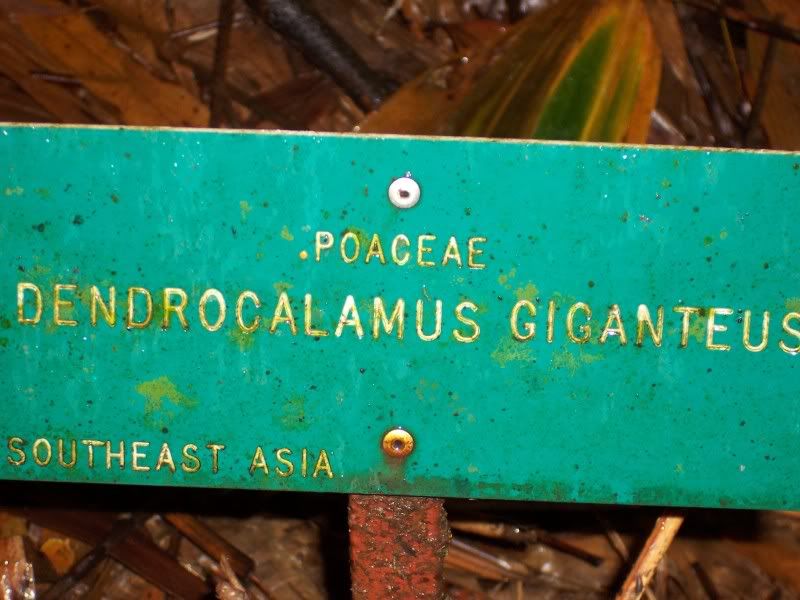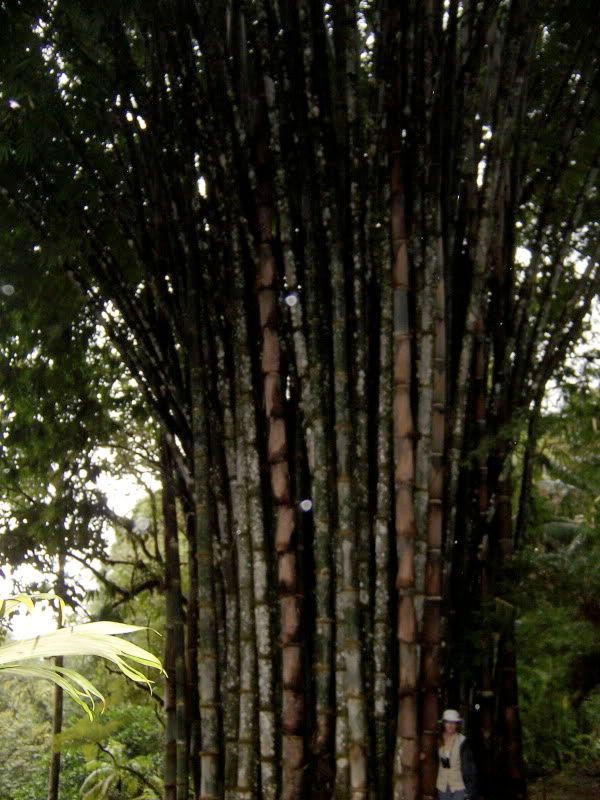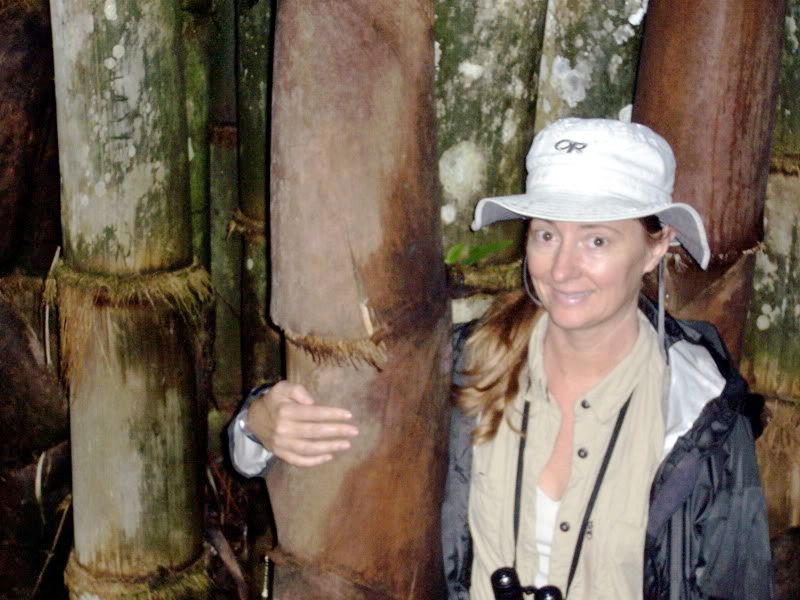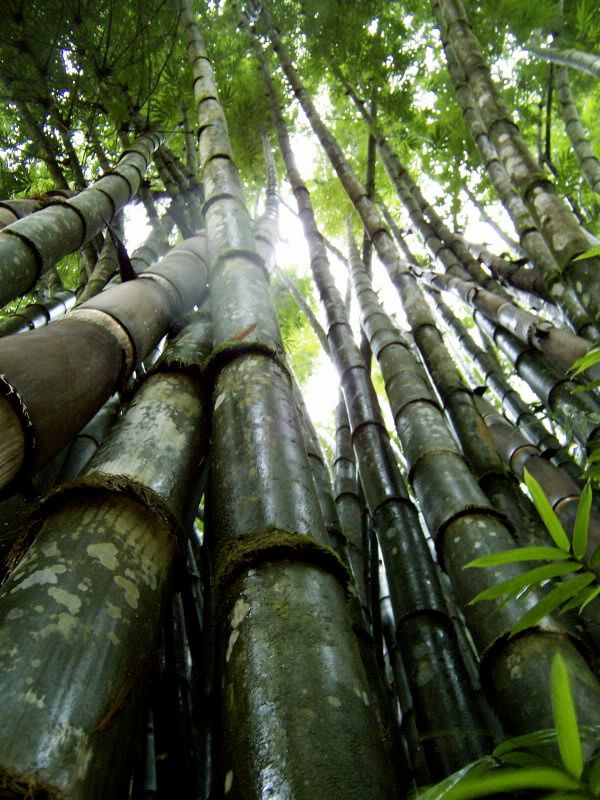
 |
A guide to Bamboo
Hi Guys :),
Since joining the forum, I have encountered many questions concerning bamboo. For those interested, I offer this generalized rule-of-thumb guide in the hopes that it will generate an evolving knowlege-base, for enthusiasts, within the body of this thread. A Beginner's Guide to Growing Bamboo :) TAXONOMY Family : Gramineae / Genus : Bambuseae / Genus : Phyllostachys Species of Bambusa tend to be tropical, clumping bamboos while the Phyllostachys tend to be temperate, runner types. (clumpers = sympodial / runners = monopodial) zB.: A runner-type is said to be a monopodial bamboo. :) SOIL PREPARATION Bamboos do best in a light, sandy, well-draining soil. Additions of peat, compost, and/or manure are also beneficial. :) CARE : NEW SHOOTS I'm listing this first due to the sensitivity of the new shoots. Bamboos typically send up new shoots in the spring but sometimes in the fall, as well. These shoots are Extremely Sensitive. The shoots rise from the ground with neither leaf nor limb. The growing leaves & limbs are contained within tan sheaths between the nodes. Hand pressure can seriously damage these new leaves & limbs. Take care that you touch them only very Lightly until the limbs emerge from the sheaths. - The shoots are spear-headed & are the diameter they will remain after rising from the ground. Once they've reached the height they will be, within a week or so the leaves & limbs will unfold, extending now from the nodes. At this point, it will still take days for the leaves to reach thier full size. Once finished, with exception to periodic leaf regeneration, growth stops. :) CARE : GENERAL Bamboos tend to, usually, be quite drought resistant and require very little fertilizing. They are, however, water-lovers and will grow faster & healthier with frequent watering and a feeding every month or two. This is offered as a rule of thumb; there are species that are quite particular as concerns water and feeding. If the leaves are curled along the length of the leaf, the bamboo is thirsty. :) WIND While a potential hazard for some younger bamboos, I've found little need to provide protective structures for those 5 feet or more in stature. :) LEAF REGENERATION Every spring - sometimes fall - most of the leaves will turn yellow & drop off of the culms. Do Not Panic. Bamboo remains active & green year-round. New leaves will be produced to replace the old, worn-out ones. :) AESTHETIC CARE : GENERAL Within about 3-7 years (typical for many), culms will finally die. Wearing protective gloves, simply cut them at least 1/2 inch below ground-level as the stumps are quite firm & easy to trip-up on. :) AESTHETIC CARE : PRUNING With no damage to the plant, whatsoever, bamboos can be 'topped'. Bamboo appears to be made-up of fingers & joints. The 'joints' are called nodes. To control height (for a hedge or bush effect), simply cut at a node at the desired height. Also, thinning may be desired to ensure good sunlight; Most bamboos, with exception to some mountain types, love lots of sunlight. :) CURING TIMBER Thanx Beth! - Several methods are available. I prefer the time-honoured smoke-house technique: Within a sealed & confined space, create cement trenches in this order - A 4' wide culm trench (the length of & for the bamboo), a 2' wide walkway path, a 2' wide fire-trench (for burning wood, etc, to produce smoke), then repeat this series of trenches for the number of culm trenches required. Keep the unit tightly sealed off & smoke the culms for 2 weeks. To ensure that the culms do not curl along thier lengths, bricks may be lain to either side of the culms. The culms are now ready for building purposes. Also, blowing boric acid through the culms can help to strengthen the wood. :) PESTS Bamboos have no appreciable enemies. :) DISEASE Bamboos are resistant to virtually all known diseases. :) RADIOACTIVITY At Ground Zero, in 1945 Hiroshima Japan, the local bamboos sent new shoots through the irradiated soil a few days after the nuclear detonation. They not only grew, but thrived. :) SUBTERRANEAN ACTIVITY The rhizomes I've encountered are thick (generally 1/4" or more) and covered with a thick, gnarly mat of often hair-thin roots that can be quite sharp. The mat typically extends 2-4" from the rhizome. I always wear leather gloves when dealing with these. While most rhizomes are shallow, they can extend downward as much as 2 1/2' (small bamboos) to nearly 3' (large bamboos) into the ground. Pressures at 3 feet, however, do provide good resistance if natural clay is present at that depth (which is common). :) PROPOGATION To insure an identical species, rhizome propogation is best. In the spring, remove the soil from a rhizome (if necessary, as some rhizomes rise from the soil & snake back into the ground). Look for a bright (light-colored) bud along the upper surface. Once located, cut off a 1.5' section of the rhizome with the bright bud centered along the length. Plant in ground or pot - about an inch or so deep - and a new shoot will emerge within days, though sometimes more. :) FLOWERING Pray That It Does Not. Depending on species, Bamboos flower every 7-120 years. Moso is closer to the 120 mark. Because flowering is genetically encoded (timed) & since all bamboos, of a specific species, are propogated from a single mother plant, Flowering is Gregarious & Global: When a specific species flowers, it flowers all over the world and, within a short given time, dies all over the world. While the flowers share a similar, visual structure with Bird of Paradise, they are Quite UN-spectacular, have no scent, no appreciable color, & produce no nectar. Pollination is strictly air-borne & by Incidental contact. :) HISTORICAL FLOWERING In the 1960's, Phyllostachys Bambusoides 'Castillonis' flowered. At the same moment, all of that species flowered all over the world. Bamboo enthusiasts in Germany collected seeds in an attempt to preserve the species. Thier efforts were successfull. The species was later re-introduced to the U.S. by the ABS (American Bamboo Society). A beautiful variably-striped bamboo, to this day, it is still somewhat scarce. :) CONTAINMENT While the root-balls of clumping bamboos expand mere inches per year, the rhizomes of runner bamboos can traverse as much as 12 feet & more per year. Since the rhizomes & new shoots can be potentially damaging to sidewalks, driveways, foundations, and other domestic structures, there is a vital need for containment. Some such infractions have actually resulted in legal suits against the enthusiast. The best protection is by digging (for larger bamboos) a 30" deep trench (in 'circular' formation). Check first to learn where underground phone lines etc are located. The trench is most effective if dug at a very slight angle outward from the containment area. For large bamboos, 30" wide, 6 mil thick, high-density polyurethane is best. Special 2-sided, task-specific tape is typically offered for sealing the ends where they meet. While a simple trench & regular patrolling (with a sharp instrument) is possible, it is much more tasking & erosion can facilitate infractions. Concrete is ineffective due to cracking underground. Posthole diggers can be used for digging the trench. Insert the polyurethane rhizome-barrier in the ground leaving about an inch of the barrier above ground, secure the ends firmly with the 2-sided tape, then fill in the trench with soil. The rhizomes may yet, at times, snake out of the ground & rise over the wall. Simply clip these with a sharp shovel. :) FOOD PREPARATION (Takenoko) While young bamboo shoots are generally edible, ingestion of sufficient quantity of raw shoots can be hazardous. Moso bamboo is somewhat bitter & Must be cooked, prior to ingestion, due to potentially toxic concentrations of cyanogens in the shoots. For additional information on edible shoots, see: http://agsyst.wsu.edu/bambroc.pdf See also, Phyllostachys Aurea - the 4th 'Interesting' Bamboo species listed below. Tabeyo!! SOME INTERESTING BAMBOO SPECIES :) DREPANOSTACHYUM KHASIANUM BAMBOO Aka, Khasia bamboo, Aka, Blue Hawaiian bamboo. This is a Mountain bamboo of the genus Bambusa. A beautiful blue bamboo with purple bands above the white nodes and rainbow-like blue, horizontal colorations. Hates southwest & lower southern states... but I Luv a challenge! Origins are the lower elevations of the Himalayas in Nepal, Sikkim, & Bhutan. Hardy to 20 degrees F. Recommended for USDA zones 8b-9. Hates high-heat & humidity. Grows to 20' tall with a 1-1.5" culm. Performs best in a shady location. :) PHYLLOSTACHYS HETEROCYCLA PUBESCENS Aka, Moso Timber bamboo, Aka, Big Timber bamboo. A runner-type & very slow grower. The largest of the temperate timber bamboos. Has thin, short, satin-like leaves. Grows from 75-90' tall with up-to 7" diameter green culms. Hardy to -5 degrees F. Young shoots are edible. The timber is used in China for construction & bridge building. Vital : Refer to "Food Preparation", above, concerning edible shoots. :) PHYLLOSTACHYS VIRIDIS Aka, Robert Young. Named after the man who first introduced it into the U.S.. A runner type. Culms start out green then turn yellow or old-gold. Though a fast grower, it tends to send up few new shoots (per year) compared to others and is, therefore, sometimes difficult to find for purchase. Culms often exhibit green vertical striping. Grows to 40' tall with 2.5-3" diameter culms. Has broad, shiney, 3-5" leaves. Hardy to -5 degrees F. Prized in Japan for fine-furniture making. Also, especially combined with Henon, the boiled shoots are quite tastey. :) PHYLLOSTACHYS AUREA Aka, Golden bamboo, Aka, Yellow Groove bamboo. Thanx for the reminder, Sandy! Common to shady woodlands of east Asia & southeast China. Canes are about 15mm diameter & about 18' tall. Hardy in Zone-6. In a reported event (Sandy), the rhizomes survived a brief period at -25 degrees F. While the canes died back, it sent up new shoots the following spring. Flowering occurs every few years. As the flowers (of this species) are hermaphroditic & since bamboo pollination is an air-borne process, covering the tops during flowering should suffice to insure seed of the identical species. Prefers a shady location. Unlike many bamboos, this one is Not drought-resistant; keep soil consistently moist. Reputed to produce the best tasting shoots of any bamboo of this genus. In the spring, harvest shoots that are 8 cm (in height) above ground-level. Cut these shoots about 5 cm below ground-level. Then grab a good recipee book! For other great Cuisine, Sweet Shoot bamboo (Phyllostachys Dulcis) is an absolute fave due to the sugary-sweet taste & because it requires much less cooking time to eliminate the inherent bitterness of bamboo. Thanx to Bob, Lorax, & Sandy0225 for inputs & for the inspiration! |
Re: A guide to Bamboo
Nicely done Jim!
Is the Blue Hawaiian a clumper or runner? |
Re: A guide to Bamboo
Thanx :) Momoese !
The Blue Hawaiian is a clumping variety and one of the most Beautiful bamboos I've ever seen - and I've seen hundreds! There's an excellent close-up shot at: Bamboo color - red bamboo, black bamboo, blue bamboo Just click on the 1st entry (in red-lettering) under "blue & white bamboos". |
Re: A guide to Bamboo
That color is amazing! Too bad it doesn't last.
|
Re: A guide to Bamboo
Are you familiar with Mexican Weeping Bamboo? I see quite a bit around town and really like the look.
|
Re: A guide to Bamboo
Quote:
|
Re: A guide to Bamboo
My favorite bamboo.
Saw it in Costa Rica last fall at the Wilson Botanical Gardens in the middle of nowhere.  My wife for scale.   Afterall...doesn't everyone want a bigger bamboo! Then a look up:  |
Re: A guide to Bamboo
Outstanding job! :woohoonaner:
|
Re: A guide to Bamboo
Did you know that bamboo can grow through a person in just a few days laying down on the ground? It was used as torture years ago.
|
Re: A guide to Bamboo
Thanx :) Bob!
Thanx for the awesome pics, Simply Bananaboos! Sorry... but that's some sweeeeeet bamboo!!!!!! Wish I could grow that here! |
Re: A guide to Bamboo
Quote:
BTW, Has anyone seen some of the incredible pressed-board lumber being made from bamboo fibers, lately :) ? |
Re: A guide to Bamboo
Good job Jim! Great thread. I was looking someting like this sometime ago.
:woohoonaner: |
Re: A guide to Bamboo
Thanx :) Ante!
Over the past more than 5 years, I found bamboo info to be very scattered & hard to locate; kind of figured it could use a little quick clarity :). Hope to see my thread attract a lot of great new info on the subject! Give it about 4 or 5 more weeks & I'll be up dancing around like that :) ! |
Re: A guide to Bamboo
Great Thread! I think this will be good for those who want to start growing bamboo. Im growing Buddha Belly from seed its only 8 inches tall but ina year or two they should be big enough to plant in ground.
|
Re: A guide to Bamboo
Quote:
Luv Buddah Belly!! Hope ya post some pics! Also, will luv hearing how that project comes along. When did ya start the seeds? |
Re: A guide to Bamboo
We have Moso, Oldhamii, and multiplex riversrun yellow and green variegated. Oldham struggles, but the rest kicks.
|
Re: A guide to Bamboo
Quote:
Also, I would like to invite members to set up 'reply' boxes, in this thread, to record thier work & progress with the various species :). I think this would be very beneficial & rewarding - especially since edits can be added to record progressively recent progress. This thread could not only be Fun but a Very Useful Resource!! :woohoonaner: |
Re: A guide to Bamboo
Quote:
This is a good source: ttp://www.bambooweb.info/ |
Re: A guide to Bamboo
Quote:
|
Re: A guide to Bamboo
Quote:
Think I see the problem. Maybe: BambooWeb - Bamboo Information and Photos All right :) !! This one works !! Still VERY Interested in hearing about MEMBER'S own special projects :) ! |
Re: A guide to Bamboo
Quote:
I have Bambusa Ventricosa I believe. |
Re: A guide to Bamboo
Quote:
I started the seeds about 3 months ago and its doing very well. Ill post some pics soon. it will some time in the future go to my Work in progress Tropical corner. |
Re: A guide to Bamboo
Quote:
|
Re: A guide to Bamboo
Quote:
:nanerwizard: :woohoonaner: :nanerwizard: |
Re: A guide to Bamboo
Quote:
|
Re: A guide to Bamboo
Michael, Im starting with 2-3 varieties from seeds. Just hope that I ll do them right:ha::ha::ha:.
Keep fingers crossed:nanadrink: I guess I can count on your help? :woohoonaner: |
Re: A guide to Bamboo
Quote:
"Blue bamboos, White bamboos and Red bamboos all have moments in their lives when they are absolutely blue, red or maybe white. But these are moments. The spectacular color usually occurs when the plant is putting up its newest canes. Blue and White bamboos throw new shoots that are covered with a lot of powder (sometimes called ‘bloom’). When the canes are covered in this powder they appear (convincingly) to be blue. If you look at the photos on this site you will see examples of this color. None of the photos have been digitally altered but they were taken at particular moments in the life of the plants." |
Re: A guide to Bamboo
Quote:
|
Re: A guide to Bamboo
Quote:
:woohoonaner: |
Re: A guide to Bamboo
Quote:
|
Re: A guide to Bamboo
Just to start the ball rolling on pix:
My Robert Young bamboo, this year. The darker green culms are Red Margin Bamboo. INFO: May 03 2004 12:26 pm : Finished planting the Red Margin Bamboo. It was a 2' tall 3-gallon plant. May 17 2004 11:32 pm : Finished planting the Robert Young Bamboo. It was an 1'4" tall 2-gallon plant. The Robert Young put up no new shoots the first year. May 18 2004 08:30 am : Found new 3'6" Red Margin shoot. May 19 2004 09:10 pm : New shoot now 4'7" tall. May 22 2004 12:30 pm : New shoot now 6'11" tall. May 23 2004 11:56 am : New shoot now 7'8" tall & discovered a new 2'11" Red Margin shoot. June 02 2004 03:38 pm : sheets of hail coming down. Later, discovered no noticeable damage to the bamboos. April 17 2005 12:56 pm : Found 18 new Red Margin bamboo shoots and, finally, 3 new Robert Young bamboo shoots. The Red Margin shoots, within a week or so, reached a height in excess of 9 feet. In same time period, Robert Youngs reached nearly 6'. A close-up of the 1.5" diameter culms. Not quite the Simply Bananas King Kongs but I Luv it! Would sure Luv to see pics of yours, guys ?) :woohoonaner: |
Re: A guide to Bamboo
|
Re: A guide to Bamboo
Thanx :) SouthLaTropical!
That's one beautiful bamboo & one great shot! :woohoonaner: |
Re: A guide to Bamboo
|
Re: A guide to Bamboo
I cant wait till mine is even half that size. heres my Bambusa Ventricosa
 |
Re: A guide to Bamboo
It'll be big in no time!
|
Re: A guide to Bamboo
Hi :) Alex (Conejov)!
Great start! I envy you - Mine's near fully grown but you? You're at the start of one fantastic adventure! You'll Luv it! :woohoonaner: Keep pics & info coming as you go... I'll be watching :) !! |
Re: A guide to Bamboo
Hi :) Mitchel (Momoese) !
Luv that variable green-striping & I've always been wild about yellow bamboos!! :woohoonaner: |
Re: A guide to Bamboo
Here's Neurolepis nana, an Ecuadorean endemic running bamboo. In the last photo, that's my friend Claudia coming up the hill - this stuff forms groves that cover whole mountainsides. It's got flechettes (little sharp spiky structures) at the base of each rosette of leaflets all along the culm, which means that one has to be cautious when travelling though it, since these are often right at eye level, and just long enough to be dangerous. Shoots of N. nana are part of the staple diet of both the Spectacled Bears and the people in the area.
   |
Re: A guide to Bamboo
Hey :) Beth, Luv those bamboo jungles!!
That makes twice, now, that I've come across bamboos that employ thorns as a defensive mechanism. Fascinating. Thanx for the great shots!! |
Re: A guide to Bamboo
I didnt know they had bamboo in Ecuador. I learned something new.
|
Re: A guide to Bamboo
Quote:
BTW, I'm new at this 'forum' stuff and have only been in Bananas.org since May 7 this year. What is 'my Work in progress tropical corner' & how do ya find it? |
Re: A guide to Bamboo
Conejo, if you really want the mindbender, we have our own bears that eat it, too.
Thank you, National Geo! They never look this nice when you come face to face with 'em in the wild...  This eats bamboo! |
Re: A guide to Bamboo
Come on fess up lorax, is that your pet? Looks kind of like a sun bear but I don't think trhey care for the tropics much. Does look to be something you'd have around the house though!
|
Re: A guide to Bamboo
Quote:
|
Re: A guide to Bamboo
Bob, I'd never keep a bear as a pet. I'm still getting used to the concept of "bears that won't eat me" truth be known - being from Northern Canada, I've got a healthy respect for "bears that will eat me" - ie Grizzlies, Blacks, Cinnamons, and Polars. The concept of a bear the size of a large German Shepherd dog, that subsists on Bamboo, is very odd to me.
I was honest when I said that was a National Geographic photo; Andean Spectacled Bears (Tremarctos ornatus) are in fairly sever danger of extinction, and I'm lucky that they range in the same forests as I do, which means that occasionally I see them. They're very shy; I'm more likely to meet Ocelots or Jaguars in the forest than I am Spectacled Bears. |
Re: A guide to Bamboo
Quote:
Woman, 65, Saves Husband, 70, from Mountain Lion Attack - Associated Content |
Re: A guide to Bamboo
LOL! Big cats here are much more scared of you than the other way on. In the case of Jaguars, because they are capable of eating me, I just freeze and let them go their merry way. Normally, this means that they stand and look at me for a while, then pass by. I won't say it's not scary, because it is, but it's also pretty cool. Smaller big cats, like the Ocelots, are always above you in the trees, and they run away pretty fast.
Puma, on the other hand, scare the living crap out of me. I've encountered them a couple of times in my travels, and I always get the feeling that what we have is an uneasy detente, and if I didn't have that big stick I might be dinner. |
Re: A guide to Bamboo
Beth sometimes I loose track of the fact that you're originally from a place where bears are true omnivores..........meaning we're on the menu occaisionally. I of all should have remembered that. Stay away from the jaguars too please..... and keep the big stick.
|
Re: A guide to Bamboo
As I said before, Jaguars and cats of that family don't bother me much. It's Pumas (Mountain Lions, Catamounts, Cougars, whatever you want to call cats that answer to Puma concolor) that give me the heebidy-jeebidies.
|
| All times are GMT -5. The time now is 10:42 PM. |
Powered by vBulletin Version 3.6.8,
Copyright ©2000 - 2025, Jelsoft Enterprises Limited.
All content © Bananas.org & the respective author.